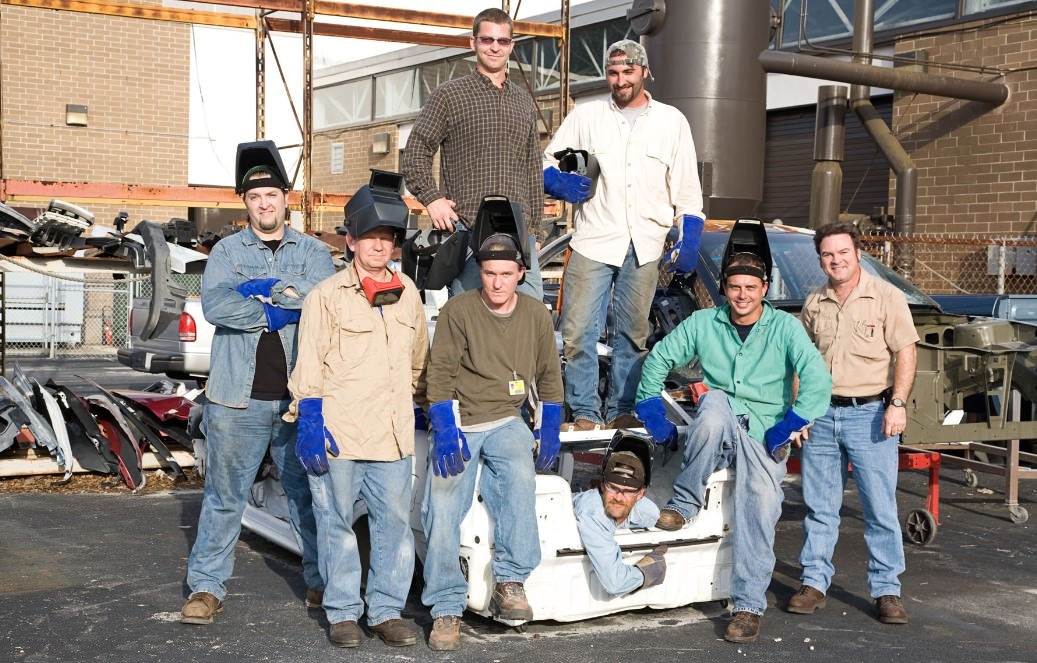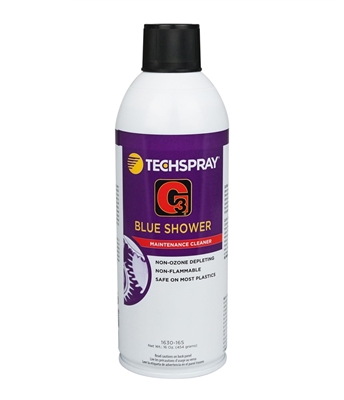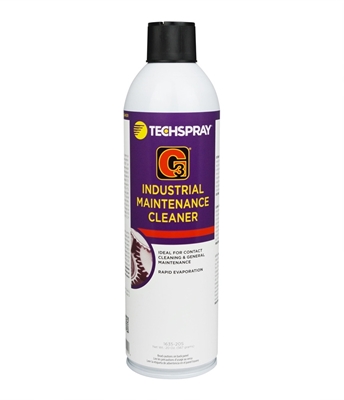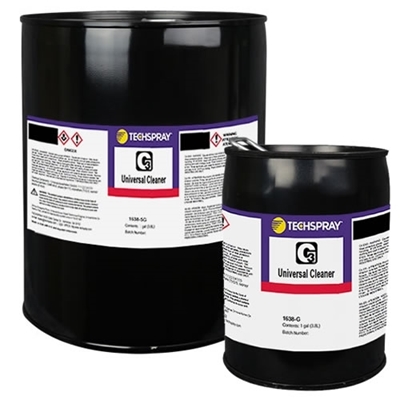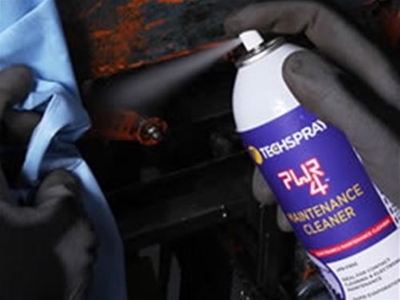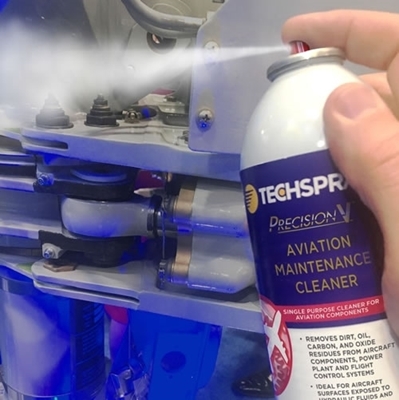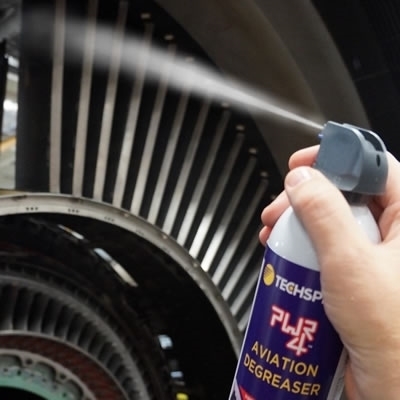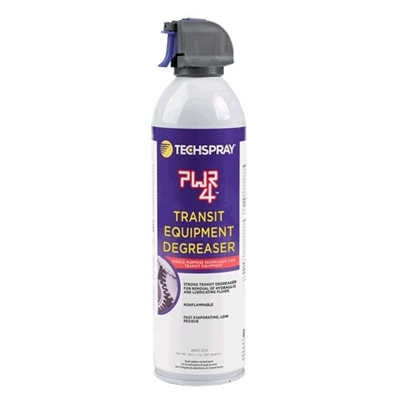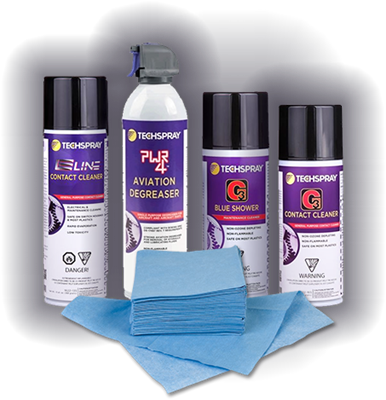Trans-1, 2 - Dichloroethylene, commonly called “trans”, is an important solvent cleaning workhorse because it has high solvency, is reasonably priced, and can easily be formulated into nonflammable blends when combined with hydrofluorocarbon (HFC), hydrofluoroether (HFE) or Hydrofluoroolefin (HFO) solvents.
The past forty years has been an ever-shifting landscape of readily available, effective, and cost-effective solvent cleaners. Ozone depletion restrictions closed the door and several classes of chemicals (CFC’s and HCFC’s), opening the door to chlorinated solvents (e.g. TCE and perc). Toxicity and environmental concerns pushed many industrial users to “safer” brominated solvents (e.g. nPB). Once again, safety concerns are rising up, stamping those solvents with a big question mark (or the GHS chronic toxicity pictogram).
As options narrow, formulators like Techspray engineered replacements by combining trans with other solvents to offer the properties needed by industry like improved safety (e.g. nonflammability) and environmental advantages (e.g. VOC and GWP).
Industrial Requirements
Solvents are required in a variety of different industrial end-use applications. Their primary function is to dissolve contaminants through a physical cleaning process removing soil, oils, wax, grease, or other contaminants from a number of substrate materials.
Solvent cleaning is required for a range of products, from printed wiring assemblies in the electronics industry to gyroscopes in the aerospace industry, and various metal parts used in machinery and other applications. Solvents are used in a variety of industrial cleaning equipment and are commonly dispensed in an aerosol form to clean various substrates, for example, electronic components.
The process of electronics cleaning, including defluxing and other cleaning operations, is an integral part of the production of high-reliability electronics. Defluxing involves the highest level of cleaning for printed wiring assemblies and other contamination-sensitive electronic applications.
The Ever-Changing Regulatory Landscape
It was discovered that chlorofluorocarbons (CFCs) and other substances such as methyl chloroform were depleting the stratospheric ozone layer that shields the Earth from the Sun’s harmful ultraviolet light. This led into the Montreal Protocol. The Montreal Protocol on Substances that Deplete the Ozone Layer is an international environmental agreement with universal ratification to protect the earth’s ozone layer by eliminating the use of ozone-depleting substances (ODS), which would otherwise allow increased UV radiation to reach the earth, resulting in higher incidence of skin cancers and eye cataracts, more-compromised immune systems, and negative effects on watersheds, agricultural lands and forests. It was agreed on 26 August 1987, and entered into force on 16 September 1989 by 46 signatories, following the first meeting in Helsinki, May 1989. This had major repercussions on how end-users cleaned metal parts, defluxed wiring assemblies on printed circuit boards, and removed contaminants from high-value precision mechanical parts and assemblies.
These substances are classified according to their ozone depletion potential (ODP), a relative index of the ability of a substance to cause ozone depletion.
|
Class 1 Substances |
ODP |
Class 2 Substances |
ODP |
|
CFC-113 |
0.8 |
HCFC-225ca |
0.025 |
|
Methyl Chloroform |
0.1 |
HCFC-225cb |
0.033 |
|
Carbon Tetrachloride |
1.1 |
HCFC-141b |
0.11 |
|
CFC-11 |
1.0 |
HCFC-123 |
0.02 – 0.06 |
The U.S. ratification of the Montreal Protocol on Substances that Deplete the Ozone Layer in 1988 and the subsequent Clean Air Act Amendments of 1990 (CAAA) created Significant New Alternative Policy (SNAP). A program established to phase out the use of chemicals that deplete the ozone layer. Industrial cleaning in the United States has changed dramatically over the past 15 to 20 years.
The Frank R. Lautenberg Chemical Safety for the 21st Century Act is a law passed by the 114th United States Congress and signed into law by US President Barack Obama in June 2016. Administered by the United States Environmental Protection Agency, which regulates the introduction of new or already existing chemicals, the Act amends and updates the Toxic Substances Control Act (TSCA) that went into force in 1976.
There were the first 10 chemical substances that the EPA initiated risk evaluations for process in December 2016. We support this list one hundred percent and applaud the EPA for taking action on these chemicals shown in Table 1.
Table 1: Most widely used chemicals for cleaning and vapor degreasing around the world:
|
Chemicals |
Yearly |
Threshold Limit Value for 8 hrs |
Carcinogenic effects on human |
Further information |
| Perchloroethylene (Perc)
|
250-500 million pounds |
25 ppm |
The E.P.A. has classified it as likely to be carcinogenic to humans, as it is associated with bladder cancer, non-Hodgkin lymphoma and multiple myeloma. It is also a drinking-water contaminant High-level inhalation exposure is associated with kidney dysfunction; affect the liver and the immune and reproductive systems.
|
OSHA and RCRA standards must be met. EPA issued Maximum Achievable Control Technology requirements under the Clean Air Act for vapor degreasing in November 1994.
|
| Trichloroethylene (TCE)
|
100-250 million pounds
|
10 ppm |
Carcinogenic to humans as it cause cancer of the liver, kidneys and blood. Animal studies suggest that it may also be a factor in birth defects, testicular cancer, leukemia, lymphomas and lung tumors. TCE is also a drinking-water contaminant |
OSHA and RCRA standards must be met. EPA issued Maximum Achievable Control Technology requirements under the Clean Air Act for vapor degreasing in November 1994.
|
|
N-Propyl bromide (nPB) |
10-50 million pounds |
10 ppm |
Carcinogen as it causes lung, colon, and skin cancer. In addition to this it is also a reproductive toxicant and shown neurotoxicity. Neurologic effects can appear as headaches, dizziness, loss of consciousness, slurred speech, confusion, difficulty walking, muscle twitching, and/or loss of feeling in arms and legs. |
EPA recommends the use of personal protective equipment, including chemical goggles, flexible laminate protective gloves and chemical-resistant clothing; EPA expects that all users of nPB would comply with any final Permissible Exposure Limit that the Occupational Safety and Health Administration issues in the future under 42 U.S.C. 7610(a).
|
| Methylene Chloride (MC)
|
250-500 million pounds |
25 ppm |
Cancer of the liver, brain, and lung, as well as non-Hodgkin’s lymphoma or multiple myeloma Liver toxicity Kidney toxicity Reproductive toxicity Nervous system effects such as cognitive impairment, effects on attention
|
OSHA and RCRA standards must be met. EPA issued Maximum Achievable Control Technology requirements under the Clean Air Act for vapor degreasing in November 1994. |
All these chemicals listed in table 1 are part of the SNAP program; however, after 15 years of research and industrial use they have exhibited toxicity and carcinogenic effects.
Regulatory Impact on Industrial Applications
The solvent cleaning industry is divided into four end-uses 1) electronics cleaning; 2) metal cleaning; 3) precision cleaning, and 4) aerosol solvent cleaning.
Historically, CFC-113 was the favored cleaning solvent particularly for end-use applications where flammability issues were a concern. Chlorinated solvents (i.e., perchloroethylene, TLV 25ppm 8 hour threshold: trichloroethylene, TLV 10ppm 8 hour threshold, and methylene chloride TLV 25ppm 8 hour threshold) have been manufactured, and used for many years, by the U.S. solvent industry for a diverse number of cleaning applications. However, a recent market trend indicates a focus away from these chlorinated solvents because of their health, safety, air pollution, and hazardous waste concerns.
One can argue that hydrocarbon and oxygenated solvents have high polarity, moderate to powerful solvency, and varying toxicity. Although these solvents are flammable and often inadequate for removing difficult contaminants such as waxes and grease, they have proven to be effective for final, touch up cleaning of various electronics applications and certain precision components in the aerospace industry. However, if the intended use is in a vapor degreaser the price of the solvent itself is offset by the costs associated with expensive explosion-proof equipment which is necessary because of the low flash points associated with these solvents. The overall use of hydrocarbon and oxygenated solvents in the cleaning industry is considered relatively low given these limitations. (source:epa.gov )
The Search for Safer Alternatives
In reducing and eliminating the use of Class II ODS Solvent Cleaners, formulators with talented chemists and a strong knowledge of industrial applications, engineered many products to be effective and sometimes superior replacements. Most commonly, trans-1,2-dichloroethylene is combined with HFC, HFE, or HFO solvents to create blends that are nonflammable, have strong cleaning ability for specific types of soils, have good substrate compatibility, and meet environmental requirements like volatile organic compound (VOC) and global warming potential (GWP) restrictions.
Trans-1,2-dichloroethylene, commonly referred to as “trans” is an aggressive solvent which because of its flammability, is most always combined with other solvents, such as HFCs and HFEs to form nonflammable effective azeotropes. The powerful solvency of trans makes for a more aggressive solvent product, which can be used to enhance cleaning performance. Solvent blends with trans are commonly used in vapor degreasing equipment for electronics, metal, and precision cleaning, and is also used as an aerosol solvent cleaner. EPA considers trans an acceptable alternative for CFC-113, methyl chloroform, and HCFC-141b.
Although trans is technically chlorinated (contains a chlorine atom), it has a far superior toxicity profile compared to the solvents covered in The Frank R. Lautenberg Chemical Safety for the 21st Century Act, like TCE, perc, and methylene chloride. Exposure limits for TCE, perc, and methylene chloride range between 25 and 50 parts per million (ppm), so to keep workers safe, companies must provide personal protection equipment (PPE) or ventilation that maintains exposure below those limits. Trans blends tend to have exposure limits above 200 ppm, allowing trans-based products to be used more safely in a greater number of real-world applications.
Techspray® trans-based products include:
- G3® Powerful, Nonflammable Cleaners – Originally formulated as a replacement for HCFC-141b, G3 products have been top-selling Techspray cleaners for over 15 years. They are nonflammable, powerful cleaners, and safe on most plastics. There are a range of aerosol cleaners available, including G3 Blue Shower Maintenance Cleaner, G3 Flux Remover, and G3 Contact Cleaner. The G3 Universal Bulk Cleaner is effective for immersion and ultrasonic cleaning processes.
- PWR-4™ High Performance Cleaners PWR-4 was engineered as a safer alternative to nPB, TCE and other highly toxic cleaning solvents. It offers powerful cleaning action, low toxicity, at a cost effective price. PWR-4 Maintenance Cleaner,PWR-4 Aviation Cleaner , and PWR-4 Transit Cleaner are aerosol products for maintenance operations. Bulk liquid packaging is also available for safer vapor degreasing, ultrasonic, and immersion cleaning.
- Precision-V™ Precision Cleaners – Precision-V solvent cleaners are high precision alternatives to AK225, which is no longer available because of ozone depletion restrictions. A wide variety of formulas are available in aerosol and bulk liquid for safer vapor degreasing, ultrasonic, and immersion cleaning to fit performance, substrate compatibility, or environmental requirements.
Additional reading:

